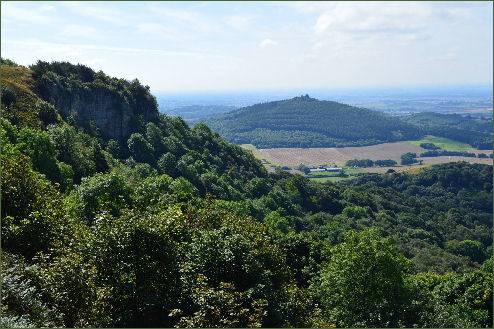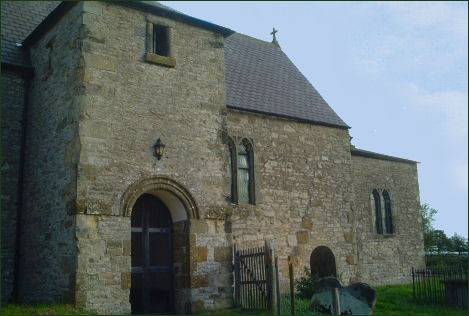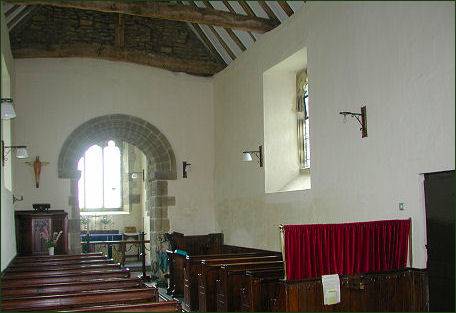Old Byland
OS grid reference:- SE 551 859
 The small, attractive village of Old Byland is situated near to Cold Kirby and Scawton, and lies 4½ miles to the north west of the picturesque market town Helmsley in the beautiful North York Moors National Park.
The small, attractive village of Old Byland is situated near to Cold Kirby and Scawton, and lies 4½ miles to the north west of the picturesque market town Helmsley in the beautiful North York Moors National Park.
After the Norman conquest the whole area was completely devastated by William the Conqueror during the ferocious 'Harrowing of the North' in response to Anglo-Saxon resistance to his rule. In 1086 the Domesday Survey records only two surviving settlements in the whole of upper Ryedale, Helmsley and Old Byland.
The nearby scenic ruins of Byland Abbey are located in a peaceful setting at New Byland, near the village of Coxwold. The abbey was founded at Calder during the reign of King Henry I by the Savigniac monks of Furness Abbey in Cumbria in 1135. The order had its origins in 1105 when Vitalis of Mortain established a hermitage in the forest of Savigny. The monks of the order later followed the Benedictine Rule, wore grey habits and founded daughter-houses.
The Battle of Old Byland
Old Byland was the scene of a significant medieval battle between the Scots and English on 14 October 1322, forming part of the Wars of Scottish Independence. The Battle of Old Byland or also known as the Battle of Byland Moor was a victory for the Scots, the most significant since the Battle of Bannockburn, though on a far smaller scale. The exact location of the battle is uncertain, although it was somewhere around Old Byland.
 Edward II advanced north for a second campaign in Scotland. The Bruce, however, was ready for him,and employed scorched earth tactics against the English. Edward visited Edinburgh, with no tactical strike on the Scots, his army tired and hungry, Edward bade a dispirited retreat.
Edward II advanced north for a second campaign in Scotland. The Bruce, however, was ready for him,and employed scorched earth tactics against the English. Edward visited Edinburgh, with no tactical strike on the Scots, his army tired and hungry, Edward bade a dispirited retreat.
The Battle of Bannockburn had emboldened the Scots and Robert The Bruce decided to take the war into England. King Edward II stubbornly refused to recognise him as King of England. Robert the Bruce crossed the Solway making his way towards Yorkshire, accompanied by a large number of troops recruited in Argyll and the Isles.
On his return from Scotland, King Edward II had taken up residence at nearby Rievaulx Abbey with his Queen, Isabella of France. The Scots made a sudden and unexpected approach in mid-October. The night before the battle, the Scots had performed a night march from their previous position at North Allerton, hoping to surprise the enemy. Instead they met with a steep escarpment, known today as Sutton Bank. A large English force under the command of John of Brittany, Earl of Richmond, stood on Scawton Moor, between the advancing Scots and the King and Queen.
To dislodge the English from their strong position on the high ground, the Bruce used the same tactics that brought victory at the earlier Battle of Pass of Brander in the west of Scotland. As Moray and Douglas charged uphill a party of Highlanders scaled the escarpment on the English flank and charged downhill into Richmond's rear.
English Resistance crumbled and the Battle of Old Byland turned into a rout. Richmond himself was taken prisoner, as were Henry de Sully, Grand Butler of France, Sir Ralph Cobham and Sir Thomas Ughtred. Many others were killed in flight. King Edward II himself was forced to make a rapid and undignified exit from Rievaulx, fleeing in such haste that his personal belongings were left behind. Old Byland sent a clear message to Edward that in this First War Of Scottish Independence, Robert Bruce could strike in England too.
The Church of All Saints
The ancient church of All Saints at Old Byland, a Grade I Listed Building, dates to the late Saxon era. Most of the present church was rebuilt during the Norman period, but the stonework in the exterior of the chancel suggests that once the roof was lower and this implies that parts of the building are likely to be pre-Norman. Furthermore, a late Saxon doorway, which is now filled in, in the exterior of the chancel also suggests that an earlier church existed on this site before the Norman rebuilding. The church has undergone many alterations over the centuries and was partly rebuilt in the fourteenth or fifteenth century.


Embedded in the outer wall of the porch on the eastern side is an ancient Saxon sundial. A rough stone basin stands in the chancel, during the nineteenth century it is recorded as standing on the village green. It may date back to the Viking period, or even be Romano-British. The eighteenth century wooden cover over it used to belong to the font.
In the 1130s when the Byland monks, originally based at Calder in Cumbria were driven out by the Scots, they were provided lands at Old Byland. The church at Old Byland remained in the hands of Byland Abbey afterwards.
